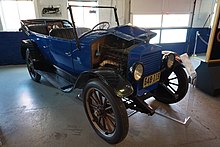




The Essex was a brand of automobile produced by the Essex Motor Company between 1918 and 1922, and by Hudson Motor Car Company of Detroit, Michigan between 1922 and 1933.
Corporate strategy
During its production run, the Essex was considered a small car and was affordably priced. The Essex is generally credited with starting a trend away from open touring cars design toward enclosed passenger compartments. [1]
Originally, the Essex was to be a product of the "Essex Motor Company," which was a wholly owned entity of Hudson. Essex enjoyed immediate popularity following its 1919 introduction. Essex Motors went so far as to lease the Studebaker auto factory in Detroit for the production of the car. More than 1.13 million Essex automobiles were sold by the time the Essex name was retired in 1932 and replaced by the Terraplane. That year the Essex Motor Company was dissolved and the cars officially became a product of Hudson.
Essex cars
Essex cars were designed to be moderately priced cars which would be affordable to the average family. Proving durable, their capabilities were checked upon and confirmed by AAA and the United States Post Office. In 1919, an Essex completed a 50-hour, 3,037.4 miles (4,888.2 km) endurance test in Cincinnati, Ohio, at an average speed of 60.75 miles per hour (97.77 km/h). [2] The early Essex cars also captured many hill climb records. In a special Essex race car, Glen Shultz won the 1923 Pikes Peak Hill Climb. [3] It had a 108.5-inch (2,760 mm) wheelbase. [2]
Initially, Essex marketed a line of touring cars (open four-door cars with canvas tops), which was the most popular body style of cars in production at the time. While Essex added an enclosed sedan in 1920, it was the introduction of the 1922 closed coach, priced at $1,495 (US$27,213 in 2023 dollars [4]), $300 above that of the touring car. By 1925, the coach was priced below the touring car. While Henry Ford is credited with inventing the affordable car, it was Essex that made the enclosed car affordable. [5]
In 1928, the big news was the use of four-wheel mechanical brakes. [2] Essex boasted "piano hinge doors" which were exceptionally strong. An advertisement shows a man fully supported by an open door to demonstrate the strength of the hinge.
1926 Specs
- Wheelbase = 110.5 in (2,807 mm) [6]
- Length = 14 ft 6 in (4,420 mm) [7]
- Turning Radius = 23 ft (7.0 m) [6]
- Road Clearance = 8.75 in (222 mm) [6]
- Brakes = 14 in (356 mm) drums [6]
By 1929, the Essex was third in U.S. sales, behind Ford and Chevrolet. [8]
Essex sales remained strong into 1931 before sales began to trend downward. For 1932 a redesigned Essex debuted and was named the Essex-Terraplane, a play on the word aeroplane. For 1934 the Essex name was dropped and the car was marketed as the Terraplane.
The instrument panel of the 1932 Hudson and Essex automobiles featured the first use of " warning lights" instead of gauges.
Essex production models
International production
Essex motor vehicles were either exported as complete cars or locally built from knock-down kits in many countries, making the Essex marque well known internationally as well as domestically. Essex vehicles were locally built in Canada, the United Kingdom, Germany, Australia, New Zealand, and South Africa.
Gallery
- Essex Super Six Automobiles
-
1927 Essex Super Six Speedabout
-
1928 Essex Super Six 4-Door Sedan
-
1929 Essex Super Six Coupé
-
1930 Essex Super Six 4-Door Sedan
-
1930 Essex Super Six Model E Coupé
-
1930 Essex Super Six Model E 4-Door Sedan
-
1931 Essex "Boattail"
References
- ^ Lamm, Michael; Holls, Dave (1996). A century of automotive style: 100 years of American car design. Lamm-Morada. p. 29. ISBN 9780932128072. Retrieved 30 June 2012.
- ^ a b c Kimes, Beverly (1996). Standard Catalog of American Cars 1805-1942. Krause Publications. ISBN 0-87341-428-4.
- ^ "Essex cars article". Remarkablecars.com. Archived from the original on 2013-07-08. Retrieved 2012-05-31.
- ^ 1634–1699: McCusker, J. J. (1997). How Much Is That in Real Money? A Historical Price Index for Use as a Deflator of Money Values in the Economy of the United States: Addenda et Corrigenda (PDF). American Antiquarian Society. 1700–1799: McCusker, J. J. (1992). How Much Is That in Real Money? A Historical Price Index for Use as a Deflator of Money Values in the Economy of the United States (PDF). American Antiquarian Society. 1800–present: Federal Reserve Bank of Minneapolis. "Consumer Price Index (estimate) 1800–". Retrieved February 29, 2024.
- ^ Swift, Earl (2011). The Big Roads: The Untold Story of the Engineers, Visionaries, and Trailblazers Who Created the American Superhighways. Houghton Mifflin Harcourt. p. 88. ISBN 9780618812417. Retrieved 30 June 2012.
- ^ a b c d "1926 Essex Instruction Book". Oldcarbrochures.com. Retrieved 2012-05-31.
- ^ 1926 Hudson & Essex mechanical specifications & adjustments (PDF). hudsonterraplane.com. Archived from the original (PDF) on 2010-12-18. Retrieved 2012-07-01.
- ^ "1922 Affordable Closed Cars". Popular Mechanics. 173 (5): 50. May 1996. Retrieved 30 June 2012.






